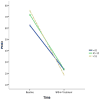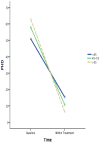Age-based differences in treatment outcome among alcohol-dependent women
- PMID: 22369224
- PMCID: PMC3371280
- DOI: 10.1037/a0027383
Age-based differences in treatment outcome among alcohol-dependent women
Abstract
The literature suggests that women are at higher risk for negative consequences from alcohol use than men and that these risks are compounded by age. The current study investigated how alcohol-dependent women from different age groups might differ in terms of baseline functioning and treatment response. The sample consisted of 181 participants drawn from two randomized clinical trials of cognitive-behavioral treatments for alcohol-dependent women. Demographic and psychopathology data were obtained at baseline using the SCID (Structured Clinical Interview for DSM disorders) I for Axis I disorders and the SCID II or Personality Disorders Questionnaire for Axis II disorders. Social networks data were collected using the Important People and Activities Interview. Drinking data were collected at baseline and follow-up using the Timeline Follow Back Interview. ANOVAs revealed that older women had better psychosocial functioning in terms of being better educated and reporting fewer Axis I disorders. Also, older women had more supportive social networks in terms of more people, a smaller percentage of heavy drinkers, and a nondrinking spouse. Older women reported a less severe lifetime substance use history with a later age of first drink, later onset of alcohol use disorders, fewer lifetime abuse/dependence items, and less drug use. However, they reported drinking more frequently and more heavily over the 90 days prior to treatment. Finally, older women were more compliant with treatment and responded better by reducing drinking frequency and percentage of heavy drinking days. Suggestions to enhance treatment efficacy for younger women are made as well as suggestions for future research.
PsycINFO Database Record (c) 2012 APA, all rights reserved.
Figures



References
-
- Adams WL, Barry KL, Fleming MF. Screening for problem drinking in older primary care patients. JAMA. 1996;276(24):1964–1967. - PubMed
-
- Atkinson RM. Treatment programs for aging alcoholics. In: Beresford T, Gomberg E, editors. Alcohol and aging. New York: Oxford University Press; 1995. pp. 186–210.
-
- Baillie AJ, Stapinski l, Crome E, Morley K, Sannibale C, Haber P, Teeson M. Some new directions for research on psychological interventions for comorbid anxiety and substance use disorders. Drug and Alcohol Review. 2010;29:518–524. - PubMed
-
- Brady TM, Ashley OS, editors. DHHS Publication No SMA 04-3968, Analytic Series A-26. Rockville, MD: Substance Abuse and Mental Health Services Administration, Office of Applied Studies; 2005. Women in substance abuse treatment: Results from the Alcohol and Drug Services Study (ADSS)
-
- Blow F. DHHS No (SMA) 98-3179. Washington, DC: US Government Printing Office; 1998. Substance abuse among older Americans.

